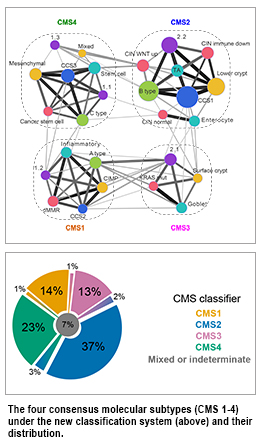CityU helps develop new classification system for colorectal cancer
Karen Cheng
City University of Hong Kong (CityU) has contributed to the development of a new molecular classification system for colorectal cancer (also commonly known as large bowel cancer), with highly significant potential for treatment and prognosis. This new finding is hailed by medical professionals as a significant advancement.
Dr Wang Xin, Assistant Professor in the Department of Biomedical Sciences at CityU, together with scientists in an international consortium from leading cancer research institutes in the US and Europe, has combined six independent classification systems for colorectal cancer and derived a most robust and new classification system using data collected from over 4,000 colorectal cancer patients around the world.
Based on this new classification system, close to 90% of all colorectal cancer can be classified into four consensus molecular subtypes (CMS1-4) with each CMS having its own characteristic molecular and clinical features.
For instance, colorectal cancer patients classified to be CMS4 have an increased risk of distant metastasis and overall poorer survival rates. In contrast, colorectal cancer patients classified as CMS2 had much better survival rates even if the cancer returned.
The team’s research was published in the latest issue of the prestigious journal Nature Medicine in 2015.
The problem with treatment for colorectal cancer is the diverse clinical outcomes and responses to drugs. That is why it is difficult to identify the best treatment, leading to possible delays and economic burden, according to Dr Wang.
“The significance of this finding is that there is now a consensus on a new and robust classification system for colorectal cancer, which will allow doctors to optimise treatment for each type of colorectal cancer,” Dr Wang said.
Professor Lu Jian, Vice-President (Research and Technology) at CityU, expressed his excitement about the new classification system, saying it established the foundation for future clinical stratification and subtype-based targeted treatments.
“It also reflects CityU’s research capabilities in life sciences, an important strategic development direction for the University,” he said.
Colorectal cancer is the second leading cause of cancer-related death in Hong Kong. In 2013, there were 1,981 deaths from this disease, representing about 15% of all cancer deaths. Over 4,500 new cases were diagnosed in 2012.
That’s why doctors and medical professionals in the territory welcomed this breakthrough.
“The study is the largest ever collaborative, multidisciplinary effort in the colorectal research community aimed at synthesising a consensus classification of this heterogeneous cancer from clinical, prognostic and molecular data,” said Dr Joseph Au Siu-kie, Consultant Clinical Oncologist at Queen Elizabeth Hospital, and Chairman of Research Committee of Kowloon Central Cluster, Hospital Authority.
“The implications may be far reaching. It provides a solid foundation for other investigators to identify the driver genetic changes and potential therapeutic targets, and to study the clinical response to various treatments for different subsets of this common cancer,” Dr Au said.
“The classification would help doctors to decide which patients needed more aggressive treatment and who did not, relieving some patients from unnecessary side effects from treatment,” said Dr Timothy Yip Tak-chun, Chief Scientist of the Cancer Research Unit at Queen Elizabeth Hospital.
“This research finding will have far reaching implications for the future treatment of colorectal cancer and represents a brilliant achievement in the advancement of biomedicine,” Dr Yip added.
Dr Wang said current diagnostic procedures for identifying subtypes were rather sophisticated. That’s why the foci of future research at CityU would be to develop molecular biomarkers that could provide diagnosis and prognosis within a shorter period of time, and also to develop therapies tailored for each of the subtypes.

